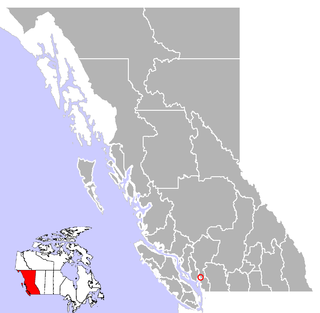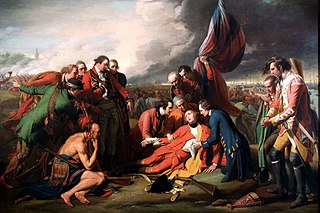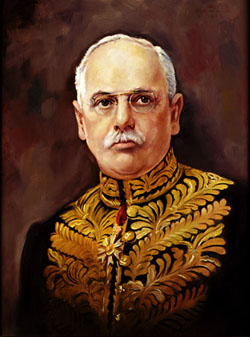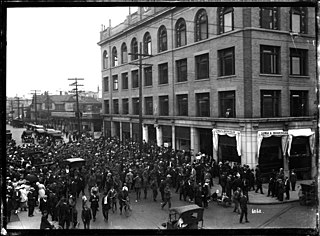This article contains information about the literary events and publications of 1991.

Britannia Beach is a small unincorporated community in the Squamish-Lillooet Regional District located approximately 55 kilometres north of Vancouver, British Columbia on the Sea-to-Sky Highway on Howe Sound. It has a population of about 300. It includes the nearby Britannia Creek, a small to mid-sized stream that flows into Howe Sound that was historically one of North America's most polluted waterways.

The history of British Columbia covers the period from the arrival of Paleo-Indians thousands of years ago to the present day. Prior to European colonization, the lands encompassing present-day British Columbia were inhabited for millennia by a number of First Nations.

Albert "Ginger" Goodwin, nicknamed Ginger for his bright red hair, was a migrant coal miner who advocated for workers' rights and promoted the cause of unions in British Columbia, Canada. Angered by the working conditions in coal mines, Goodwin sought to increase wages and improve working conditions, and fought companies that disregarded workers' rights. He participated in and led multiple strikes, and served as a delegate for the British Columbia Federation of Labour and as an organizer for the Socialist Party of Canada. In the years following his increased activism and involvement with labour unions, Goodwin fell under scrutiny for his opposition to military conscription during World War I. He was killed by a police officer in 1918. There is debate on whether Goodwin was a victim of murder or if his death was the result of the officer's self-defence. His death sparked a one-day general strike in Vancouver on August 2, 1918, which was the first general strike ever held in Canada. The strike was a precursor of the Winnipeg general strike of 1919 and other labour conflicts.

Rossland is in the West Kootenay region of south central British Columbia. High in the Monashee Mountains, the city lies immediately east of the intersections of BC highways 3B and 22. The facilities provide a winter base for the nearby multi-peak ski hills of the Red Mountain Resort. In the non-winter months Rossland is frequented by mountain bikers, with golf and fishing options nearby as well.

Teck Resources Limited, known as Teck Cominco until late 2008, is a diversified natural resources company headquartered in Vancouver, British Columbia, that is engaged in mining and mineral development, including coal for the steelmaking industry, copper, zinc, and energy. Secondary products include lead, silver, gold, molybdenum, germanium, indium and cadmium. Teck Resources was formed from the amalgamation of Teck and Cominco in 2001.
Anyox was a small company-owned mining town in British Columbia, Canada. Today it is a ghost town, abandoned and largely destroyed. It is located on the shores of Granby Bay in coastal Observatory Inlet, about 60 kilometres southeast of Stewart, British Columbia, and about 20 kilometres, across wilderness east of the tip of the Alaska Panhandle.

Cumberland is an incorporated village municipality east of Perseverance Creek, near the east coast of central Vancouver Island, British Columbia. The Comox Valley community is west of BC Highway 19 and is by road about 105 kilometres (65 mi) northwest of Nanaimo and 10 kilometres (6 mi) southwest of Courtenay.
Mark Leier is a Canadian historian and, since 1994, a professor of working class and left-wing history at Simon Fraser University (SFU). From 2000 to 2010, he was the director of the Centre for Labour Studies at Simon Fraser.

Arthur Herbert "Slim" Evans was a leader in the industrial labour union movement in Canada and the United States. He is most known for leading the On To Ottawa Trek. Evans was involved in the Industrial Workers of the World, the One Big Union, and the Worker's Unity League. He was a member of the Communist Party of Canada.
The Socialist Party of British Columbia (SPBC) was a provincial political party in British Columbia, Canada, from 1901 to 1905. In 1903, the SPBC won seats in the Legislative Assembly of British Columbia.

Sir Francis Stillman Barnard was a Canadian parliamentarian and the tenth Lieutenant Governor of British Columbia. Barnard is often referred to as Frank Barnard, as was his father Francis Jones Barnard, who as the founder of Barnard's Express, was one of BC's more notable pioneer entrepreneurs.

The 1918 Vancouver general strike was a general strike that took place in response to the death of Albert "Ginger" Goodwin on 2 August 1918. It was the first general strike in the history of British Columbia and a pivotal event in the Canadian Labour Revolt, which would unfold over the following years.
This is a timeline of labour issues and events in Canada.
Taseko Mines Limited is a mid-tier copper producer located in British Columbia, Canada. It operates Gibraltar Mine, the second largest open-pit copper mine in Canada, and is in the planning stages for several other mines including the Prosperity Mine, Harmony, and Aley. All production is sold at non-hedged market based prices. The market capitalization currently is roughly 740 million dollars.
The 14th Legislative Assembly of British Columbia sat from 1917 to 1920. The members were elected in the British Columbia general election held in September 1916. The British Columbia Liberal Party, led by Harlan Carey Brewster, formed the government. Following Brewster's death in March 1918, John Oliver became Premier.
The history of Chinese Canadians in British Columbia began with the first recorded visit by Chinese people to North America in 1788. Some 30–40 men were employed as shipwrights at Nootka Sound in what is now British Columbia, to build the first European-type vessel in the Pacific Northwest, named the North West America. Large-scale immigration of Chinese began seventy years later with the advent of the Fraser Canyon Gold Rush of 1858. During the gold rush, settlements of Chinese grew in Victoria and New Westminster and the "capital of the Cariboo" Barkerville and numerous other towns, as well as throughout the colony's interior, where many communities were dominantly Chinese. In the 1880s, Chinese labour was contracted to build the Canadian Pacific Railway. Following this, many Chinese began to move eastward, establishing Chinatowns in several of the larger Canadian cities.
The Vancouver Island Coal Miners' Strike was from 1912-1914. The coal miners in the Vancouver Islands refused to go to work, in protest of unsafe working conditions and unfair treatment. They began as peaceful protests, until built up anger caused by strike-breakers, also known as scabs, ruined the effectiveness of the strike and incited aggressive behavior. The militia was forced to step in and shut down the strike.
Hayashi Studio (1911–1942) was a film photography studio run by Japanese-Canadian photographers in Cumberland, British Columbia. The studio was closed shortly before the internment of Japanese-Canadians, as part of a broader climate of racism and xenophobia at the time.









